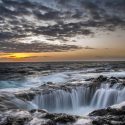There are places in the Universe where you could turn to ash, freeze to death or be completely crushed by gravity. And you’re about to visit them all. What conditions make some of these exoplanets so dangerous? What would happen if you set foot on them? And which planet would slash you up to bits and pieces?
Earth exists in the precious Goldilocks zone of our Solar System. That means that its orbit is within a distance from the Sun at which liquid water could exist on the surface.
And with liquid water, there’s the potential for life. And while the search continues for other planets in the Universe that could support life, there are many that are so dangerous you could cross them off the list right now. But before you do, why not take a death-defying journey through space to check them out. Or are you too scared?
B Cen (AB)b
Let’s start with a planet that orbits not one, but two stars. And the combined mass of this binary star system is five to six times that of the Sun. If the larger of the two stars, b Cen A, were placed in the center of our Solar System, it would be hot enough to melt rocks here on Earth. Luckily, this exoplanet is located far enough away to keep things cool enough for us.
What makes this planet so dangerous for you is that it’s gaseous, just like Jupiter. There’s no surface for you to exist on. The deeper you go, the more it could crush you. At 692 km (430 mi) down into its clouds, you’d feel atmospheric pressure that is over 1,100 times stronger than Earth’s.
Kepler-36b
Picture a super-Earth with a mass of nearly four of our home planets combined. It whips around its star in just 14 days and is too close to be in its star’s habitable zone. But those things wouldn’t be what makes it so dangerous for you. Kepler-36b and its neighbor, Kepler-36c are packed together.
Sometimes they’re only separated by less than five times the distance between Earth and the Moon. Meaning in the night sky, you’d see this other planet towering above you. But the proximity causes some huge gravitational tides.
So much so that they deform both planets. And the result? If you made a stopover here, you’d probably die from the tons of epic volcanic eruptions on the surface.
OGLE-2005-BLG-390Lb
This exoplanet has a mass of 5.5 Earths, takes nine years to make one full orbit and is located far away from the habitable zone of its dim star. That means it has a lot in common with a planet a bit closer to home, Neptune. To visit this frigid world, you’d need an especially warm space suit. Temperatures here would be about -220 °C (-364 °F). That’s even colder than liquid nitrogen.
If you accidentally inhaled the atmosphere here, your lips would instantly suffer cold burns. And your cheeks and tongue would be dealing with severe frostbite. Keep it up and you could destroy the lining of your mouth, throat and airways to your lungs.
K2-141b
Get ready to zip around a star every few hours. Because on this exoplanet, you’d make one full orbit in just 0.3 Earth days. That would be about every seven hours. K2-141b is almost 140 times closer to its star than Earth is to the Sun, and the two are tidally locked together. That means that one side of the planet always faces it.
The hot side would have temperatures as high as 3,000 °C (5,432 °F). And besides burning you to death, this heat creates other dangers. An ocean of magma as deep as 100 km (62 mi), an atmosphere of vaporized rock and supersonic winds with speeds up to 5,000 km/h (3,100 mph).
On the colder side, temperatures would plummet to as low as -200 °C ( -330 °F). If you landed here, you’d be exposed to rocks raining down from the sky. They’d hit you faster than bullets from a gun.
OGLE-TR-56B
Speaking of the weather, this next exoplanet would be one of the most insane places you could even think of stopping by. This gas giant has a mass nearly 1.5 times that of Jupiter. And yet, it’s located about 40 times closer to its star than the Earth is to the Sun.
You’d arrive to find it has an intense surface temperature of about 1,725 °C (3,140 °F). This is so hot that iron evaporates into clouds in the upper atmosphere. Check the forecast before leaving your ship or you could just get caught in a hot molten iron rainstorm that would burn you alive.
KELT-9b
If you thought that was hot, get ready to check out one of the hottest planets ever discovered. This tidally locked gas giant receives 44,000 times more energy from its star than Earth gets from the Sun. On the day side, temperatures could be as high as 4,315 °C (7,800 °F).
That would make it hotter than most stars. Even hydrogen molecules wouldn’t be able to stay intact. You’d be a goner in less than a millisecond on this planet.
PSR B1257+12
Pulsars are fast rotating neutron stars that regularly emit pulses of electromagnetic radiation. This exoplanet is a pulsar planet. So if you land here, you’d be showered in radiation ranging from visible light to X-rays and even gamma rays. Located 980 light-years away in the Virgo constellation, its pulsar star spins at an incredible 161 times per second.
And it’s also one of the smallest exoplanets ever found. It may be so small that there’d be almost no gravity to keep you in place. But it’s the radiation that would be your demise here. Acute radiation sickness would kick in within hours, and you’d experience nausea, confusion and potentially lose consciousness. Stick around for up to three days, and there’d be almost no chance you wouldn’t end up in a coma. Or dead.
HD 189733b
Don’t let this gorgeous cobalt-blue planet fool you. This world is the deadliest planet of them all. That color may look like an ocean, but what you’d be seeing are high clouds full of silicate particles. And these particles would tear your body apart. Earth exists in the precious Goldilocks zone of our Solar System.
That means that its orbit is within a distance from the Sun at which liquid water could exist on the surface. And with liquid water, there’s the potential for life. So maybe these dangerous places wouldn’t make for the most fun vacation. Why not explore a little more locally first. Like a day on every planet in our own Solar System.
Sources
- “Kepler-36 b”. 2022. exoplanets.nasa.gov.
- “Planets: An Unexpected Gas Giant Is Orbiting A Massive Pair Of Stars | New Scientist”. Chen Ly. 2021. newscientist.com.
- “Astronomers Get A Photo Of A Record-Breaking Exoplanet Around Massive Binary Stars!”. Phil Plait. 2021. syfy.com.
- “What Would Happen If Humans Tried To Land On Jupiter”. Gene Kim and Jessica Orwig. 2021. businessinsider.com.
- “OGLE-2005-BLG-390L b”. 2022. exoplanets.nasa.gov.



























